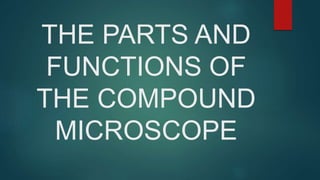
Parts and Functions of the Compound Microscope
- 1. THE PARTS AND FUNCTIONS OF THE COMPOUND MICROSCOPE
- 2. INTRODUCTION: In this lesson, you will learn about the microscope, its parts and their uses, as well as its proper care. You will also learn how a microscope works. These are essential learning skills for effective laboratory work in studying microorganisms and specimens too small to be seen by unaided eye.
- 3. TOPICS: Part of the microscope Operation of the microscope Care of the microscope
- 4. OBJECTIVES: At the end of the lessons, students should be able to: •Discuss the importance of microscope (compound microscope) and the essential usage of each part.
- 5. Microscope – is an instrument that can enlarge or magnify the image of objects that are too small to be seen by unaided eyes.
- 6. Types of Microscope Simple Microscope Compound Microscope
- 7. Simple Microscope Simple Microscope is composed of one lens and provides a weaker magnification.
- 8. Compound Microscope 2.Compound Microscope is composed of two or more lenses with powerful magnification.
- 9. There are two kinds of Compound Microscope: Compound Light Microscope (CLM); and Electron Microscope (EM)
- 10. Compound Light Microscope (CLM) Compound Light Microscope (CLM) it is commonly used microscope that used visible light to illuminate specimen. It can magnify up to 1000x.
- 11. Electron Microscope (EM) Electron Microscope (EM) is it is highly sophisticated and complex that can magnify specimen up to 100,000x. They have their own light to illuminate specimen.
- 12. There are two types of Electron Microscope (EM): Transmission Electron Microscope (TEM); and Scanning Electron Microscope (SEM)
- 13. Transmission Electron Microscope (TEM) Transmission Electron Microscope (TEM) is it is used to view the layers and details of the specimen.
- 14. Scanning Electron Microscope (SEM) Scanning Electron Microscope (SEM) is it provides a three dimensional view of the specimen.
- 15. Parts of a Microscope 1. Mirror 2. Condenser 3. Iris Diaphragm 4. Eyepiece or Ocular 5. Objectives A. Low power Objective (LPO) B. High power Objective (HPO) 6. Base 7. Pillar 8. Arm 9. Inclination joint 10. Stage 11. Body tube 12. Draw tube 13. Revolving nosepiece 14. Dust shield 15. Adjustment knob A. Course adjustment knob B. Fine adjustment knob
- 16. 1.Mirror – It is used for collecting and reflecting light through the object, lenses and into the eyes. 2.Condenser – It concentrates the reflected light from the mirror to the object being examined. 3.Iris Diaphragm – Used to regulate the intensity of light which enters the condenser. 4.Eyepiece or Ocular – Located on top of draw tube which one views the specimen. 5.Objectives – Usually attached to the revolving nosepiece. A. “Low power Objective (LPO) – The shorter tube with large lens opening and with low magnifying power for observing the general outline and locating various parts of the specimen. B. “High power Objective (HPO) – Longer tube with a small opening and higher magnifying power for studying the detailed parts of the specimen. 6.Base – The stable structure on which the microscope firmly rest. 7.Pillar – The post or upward extension of the base to which the arm is attached. 8. Arm – The curved handle of the microscope that connects the base and body tube. 9.Inclination joint – A movable hinge that attached the frame of the microscope to the base. It is used for tilting or inclining the microscope when necessary. 10. Stage – The platform on which the slide containing the specimen is held in place with pair of stage clip.
- 17. 11. Body tube – Attached the draw tube to the microscope and serves as passage way of light from the specimen to the eyepiece. 12. Draw tube – A smaller tube. It is attached to the upper part of the body tube and holds the eyepiece. 13. Revolving nosepiece – Attached to the base of the body tube, it holds and facilitates shifting of objectives. 14. Dust shield – Located above the revolving nosepiece, it keeps off the dust from the objectives. 15.Adjustment knob - Are used for lowering or raising the body tube. A. “Course adjustment knob – The larger knob used for faster movement when focusing the LPO. B. “Fine adjustment knob – Smaller knob for slow or little movement when focusing the HPO; also used to get sharper focus of the specimen under LPO.
- 18. Father of the Microscope Antonie van Leeuwenhoek is the Father of the Microscope. In total, he ground some 550 lenses, some of which had a linear magnifying power of 500 and a resolving power of one-millionth of an inch an astounding achievement.
- 19. There are three Major Parts of Microscope: Illuminating Parts; Magnifying Parts; and Mechanical Parts
- 20. 1. Illuminating Parts provide light to the microscope. 2. Magnifying Parts make the object look larger, As far as the function of the microscope is concerned, they play the most important role. 3. Mechanical Parts that support the microscope and the object being examined.
- 21. CARE OF THE MICROSCOPE 1.Carry the microscope properly by holding the arm with one hand ns supporting the base with the other hand. 2.Place the microscope on the table some six to eight centimeters away from the edge. 3.Clean the lenses and the mirror thoroughly using lens paper or soft cloth. 4.Check the following before returning the microscope. a.The microscope is clean and dry. b.It is in upright position, not inclined c.The mirror is in upright position d.The LPO is in the line with the eyepiece or ocular. The stage clips are parallel to each other pointing away from the arm